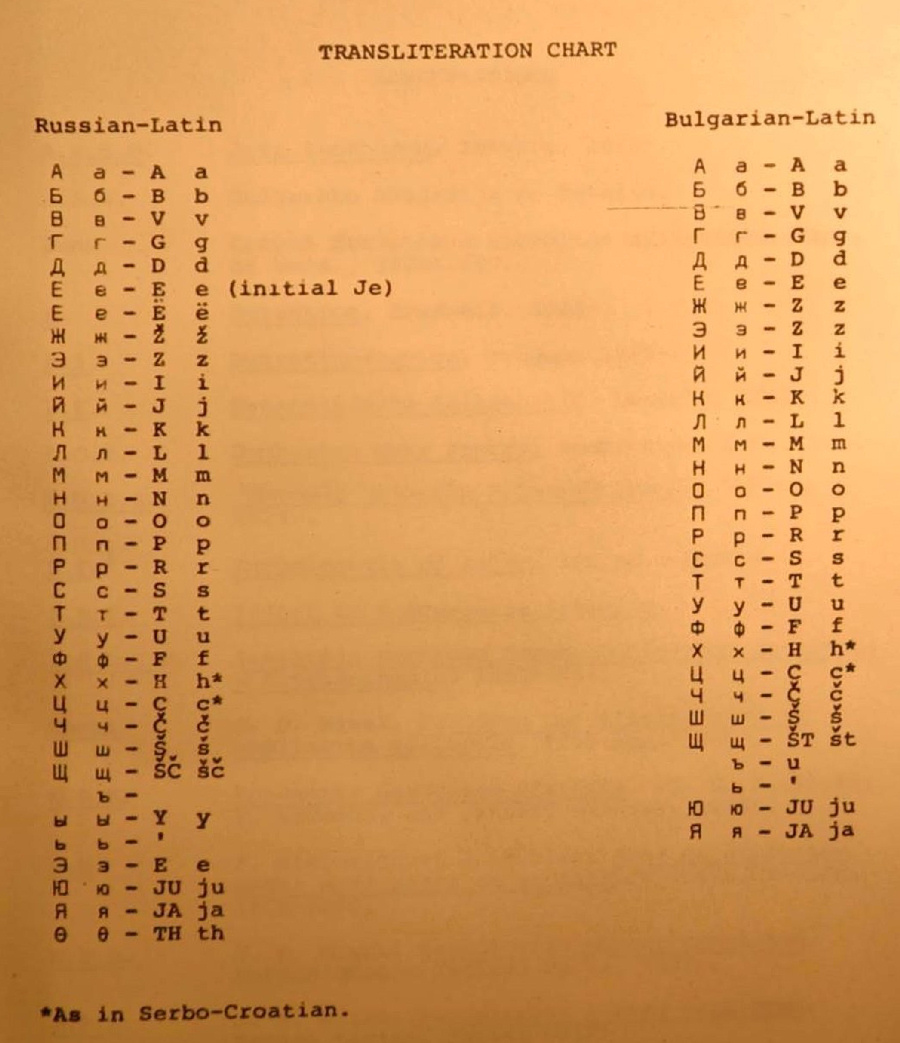A TERMINOLOGICAL AND ORTHOGRAPHICAL NOTE
In the course of this study, several terms have been used in a strictly defined sense not readily apparent to non-specialists in Slavic linguistics. The term "Old Church Slavonic" is used to define the Slavic written sources from the middle of the ninth to the end of the eleventh centuries. Likewise, the term "Middle Bulgarian" refers to the Slavic written in Medieval Bulgaria from the twelfth to the fifteenth centuries. [*] I have further tried to replace the misleading term "Proto-Bulgarian" with the simpler "Bulgar." "Bulgar" refers only to the Altaic people who came to dominate the Slavs of present-day Bulgaria during the sixth century. After the general assimilation of the Bulgars by the Slavs, I use the term "Bulgarian." "Bulgarian" represents, ethnographically, the synthesis of Altaic Bulgar and Slav into one Slavic-speaking Christian culture. This took place in the ninth century when Bulgaria became Christian under Tsar Boris I (852-889).
Orthographic charts for the various Cyrillic alphabets are provided on the next pages. In most cases they reflect the standard transliteration used in learned journals.
*. Paul Diels, Altkirchenslavische Grammatik (2 aufl.; Heidelberg: Carl Winter—Sammlung Slavischer Lehrund Handbücher, 1. Reihe: Grammatiken-6. Altkirchenslavische Grammatik, 1963), pp. 1-5.
x
![]()
Russian orthography is based on the reform of 1918 and all works which are cited in this study have had their orthography transliterated in accordance with the 1918 reform. In the case of Modern Bulgarian, I have made one slight departure from the standard transliteration of the reformed 1945 alphabet. The Modern Bulgarian ъ (pre-1945 ѫ) I have transliterated as "u" rather than "a." Although this means that I transliterate two letters, "у and ъ," as "u," the sound values to a non-specialist in Slavic orthography more closely resemble those used in actual Modern Bulgarian. The possibility for error in the case of pronunciation is also lessened. The "u" in this transcription of "ъ" is pronounced just like the "u" in Bulgaria, of which it is, indeed, a transliteration. Finally, I have, in most cases, transliterated the Medieval Greek Beta as it was undoubtedly pronounced by its speakers, as the English "v." In order to avoid confusion, I have retained the incorrect Erasmian transcription "b" for "β" in the names of the emperors Basil I and II. In all other cases, it is "v" as it was then and is now in Greek. This is particularly important in the transcription of non-Byzantine names. The relation of the name "Vardas" to the Armenian "Vartan" becomes obvious when such a transcription of Greek is employed. Greek, after all, is a living language and as much may be learned about its medieval usage from a solid acquaintance with its modern descendant as may be gleaned from its Koine predecessor.
xi
![]()
TRANSLITERATION CHART

xii
![]()
ABBREVIATIONS
A. A.S.S. — Acta Sanctorum, Antwerp, 1643-.
B.A.N. — Bulgarska Akademija na Naukite.
Bonn — Corpus Scriptorum Historiae Byzantinae, Bonn, 50 vols., 1828-1897.
B. — Byzantion, Brussels, 1924-.
Bsl. — Byzantinoslavica, Prague, 1929-.
B. Z. — Byzantinische Zeitschrift, Leipzig, 1892-.
D.O.P. — Dumbarton Oaks Papers, Washington, D.C., 1941-.
E.E.B.S. — Ἐπετρὶς Ἑταιρείας Βυζαντινῶν Σπουδῶν, Ἀθῆναι, 1924-.
E.I.1 — Encyclopedia of Islam, 1st ed., London.
I.B.I. — Izvori za Bulgarskata Istorija.
I.R.A.I.K. — Izvestija Russkogo Archeologičeskogo Instituta v Konstaninople, 1895-1914.
Mansi — J. D. Mansi, Sacrorum Conciliorum nova et amplissima collectio, Florence, 1769-.
M.G.H. — Monumenta Germanica Historia, ed. G. H. Pertz, T. Mommsen, and others, Hanover, 1826-.
M.M. — F. Miklosich et J. Müller, Acta et diplomata medil aevi sacra et profana, 6 vols., Vienna, 1860-1890.
M.P.G. — J. P. Migne, Patrologiae cursus completus, Series Graeco-Latina, Paras, 1657-.
M.P.L. — J. P. Migne, Patrologiae cursus completus, Series Latina, Paris, 1884.
Paris Corpus — Corpus Byzantinae Historiae, Lutetia Parisorum, 42 vols., Appendix, 1645-1711 + 1777 and 1819.
xiii
![]()
S.K.A.W. — Sitzungsberichte der Kaiserliche Akademie der Wissenschaften, Wien.
P.A.N. — Polskiej Akademii Nauk.
V.I.I.N.J. — Vizantiski izvori za istoriju naroda Jugoslavije, Belgrade, 1955-.
V.D.I. — Vestnik drevnej istorii, Moscow, 1938-.
V.V. — Vizantijskij Vremennik, St. Petersburg, 1894-1927. New Series, Moscow-Leningrad, 1947-.
Ž.M.N.P. — Žurnal ministerstva narodnogo prosvežčenija, St. Petersburg, 1834?-1923.
Z.R.V.I. — Zbornik radova Vizantoloskog instituta, Belgrade, 1952-.